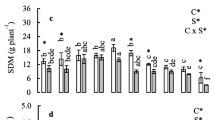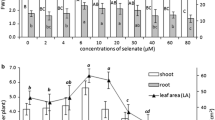Abstract
High levels of selenium can cause adverse effects in plants as well as animals. In a greenhouse experiment, rapeseed (Brassica napus) was grown in an alkaline sandy loam soil treated with different levels of selenate-Se and selenite-Se ranging from 0 to 4 mg kg−1. Total dry matter yield of selenium-treated rapeseed plants decreased significantly as compared to control plants. Plants were stressed at a very early stage of vegetative growth and produced fewer rosettes and flowers. Plant height and leaf production were negatively affected by selenate-Se. Dry matter of leaves was significantly higher in selenite- than in selenate-treated plants. Selenate-treated plants accumulated 75–160 times more Se in shoots and 2–18 times more in roots as compared to selenite-treated plants at the rosette formation stage, with this difference narrowing at peak flowering stage. Rapeseed leaves were subjected to biochemical analysis at rosette and peak flowering stages. Accumulation of selenium in leaves resulted in a significant increase in lipid peroxidation, chlorophyll, vitamin C and free amino acids, and a decrease in phenols, total soluble sugars and starch concentration.



Similar content being viewed by others
Abbreviations
- DW:
-
Dry weight
- LPO:
-
Lipid peroxidation
- Se:
-
Selenium
- TBARS:
-
Thiobarbituric acid reactive substances
References
Arvy MP (1989) Some factors influencing the uptake and distribution of selenite in the bean plant (Phaseolus vulgaris). Plant Soil 117:129–133
Arvy MP (1993) Selenate and selenite uptake and translocation in bean plants. J Exp Bot 44:1083–1087
Asher CJ, Butler GW, Peterson PJ (1977) Selenium transport in root systems of tomato. J Exp Bot 28:279–291
Bañuelos GS, Meek DW (1989) Selenium accumulation in selected vegetables. J Plant Nutr 12:1255–1272
Bañuelos GS, Ajwa HA, Terry N, Zayed A (1997) Phytoremediation of selenium laden soils: a new technology. J Environ Qual 52(6):426–430
Barrow NJ, Cartes P, Mora ML (2005) Modifications to the Freundlich equation to describe anion sorption over a large range and to describe competition between pairs of ions. Eur J Soil Sci 56:601–606
Bawa SS, Dhillon KS, Dhillon SK (1992) Screening of different fodders for selenium absorption capacity. Indian J Dairy Sci 45:457–460
Birringer M, Pilawa S, Flohe L (2002) Trends in selenium biochemistry. Nat Prod Rep 19:693–718
Brown TA, Shrift A (1981) Exclusion of selenium from proteins of selenium tolerant Astragalus species. Plant Physiol 67:1051–1053
Cartes P, Gianfreda L, Mora ML (2005) Uptake of selenium and its antioxidant activity in ryegrass when applied as selenate and selenite forms. Plant Soil 276:359–367
Clegg KM (1956) The application of the anthrone reagent to the estimation of starch in cereals. J Sci Food Agric 7:40–44
Dhillon KS, Dhillon SK (2003) Distribution and management of seleniferous soils. Adv Agron 79:119–184
Dhillon KS, Randhawa NS, Sinha MK (1977) Selenium status of some common fodders and natural grasses of Punjab. Indian J Dairy Sci 30:218–224
Dubois M, Gills KA, Hamilton JK, Rober PA (1956) Calorimetric method for the determination of sugars and related substances. Anal Chem 28:350–356
Eisler R (1985) Selenium hazards to fish, wildlife and invertebrates: a synoptic review. Biological Report 85 (1.5), US Fish and Wildlife Service, Washington, DC
Ellis DR, Salt DE (2003) Plants, selenium and human health. Curr Opin Plant Biol 6:273–279
Elrashidi MA, Adriano DC, Workman SM, Lindsay WL (1987) Chemical equilibria of selenium in soils: a theoretical development. Soil Sci 144:141–152
Euliss KW (2004) The effects of selenium accumulation in hydroponically grown canola (Brassica napus). J Young Invest 1:1–12
Feist LJ, Parker DR (2001) Ecotypic variation in selenium accumulation among populations of Stanleya pinnata. New Phytol 149:61–69
Finley JW, Sigrid-Keck A, Robbins RJ, Hintze KJ (2005) Selenium enrichment of broccoli: interactions between selenium and secondary plant compounds. J Nutr 135:1236–1238
Freeman JL, Zhang LH, Marcus MA, Fakra S, McGrath SP, Pilon-Smits EAH (2006) Spatial imaging, speciation, and quantification of selenium in the hyperaccumulator plants Astragalus bisulcatus and Stanleya pinnata. Plant Physiol 142:124–134
Fu LH, Wang XF, Eyal Y, She YM, Donald LJ, Standing KG, Ben Hayyim G (2002) A selenoprotein in the plant kingdom. Mass spectrometry confirms that an opal codon (UGA) encodes selenocysteine in Chlamydomonas reinhardtii glutathione peroxidase. J Biol Chem 277:25983–25991
Geering HR, Cary EE, Jones LHP, Allaway WH (1968) Solubility and redox criteria for the possible forms of selenium in soils. Soil Sci Soc Am J 32:35–40
Gissel-Nielsen G, Bisbjerg B (1970) The uptake of applied selenium from soils by plants. 2. The utilization of various selenium compounds. Plant Soil 32:382–396
Gomes-Junior RA, Gratao PL, Gaziola SA, Mazzafera P, Lea PJ, Azevedo RA (2007) Selenium-induced oxidative stress in coffee cell suspension cultures. Funct Plant Biol 34:449–456
Hamdy AA, Gissel-Nielsen G (1977) Fixation of selenium by clay mineral and iron oxides. Z Pflanzenernaehr Bodenkd 140:63–70
Hartikainen H (2005) Biogeochemistry of selenium and its impact on food chain quality and human health. J Trace Elem Med Biol 18:309–318
Hawrylak B, Szymanska M (2004) Selenium as a sulphydrylic group inductor in plants. Cell Mol Biol Lett 9:329–336
Heath RL, Parker L (1968) Photoperoxidation in isolated chloroplast. I. Kinetics and stoichiometry of fatty acid peroxidation. Arch Biochem Biophys 125:189–198
Hu Q, Xu J, Pang G (2003) Effect of selenium on the yield and quality of green tea leaves harvested in early spring. J Agric Food Chem 51(11):3379–3381
Huang Y, Xu J, Hu Q (2005) Effect of selenium on preservative quality of green tea during autumn tea-processing season. J Agric Food Chem 53:7444–7447
Kweon Y, Cheol S, Kum P, Young C, Ah J (2004) Effect of selenium source and concentrations on growth and quality of endive and pak-choi in deep flow culture. Korean J Hortic Sci Technol 22(2):151–155
Läuchli A (1993) Selenium in plants: uptake, functions and environmental toxicity. Bot Acta 106:455–468
Lee GP, Park K, Lee JM, Gross KC, Watada AE, Lee SK (1999) Quality improvement of Seoul celery by selenium in nutrient solution culture. Acta Hortic 483:185–192
Lee YP, Takahashi T (1966) An improved colorimetric determination of amino acids with use of ninhydrin. Anal Biochem 14:71–77
Levesque M, Vandette ED (1971) Selenium determination in soil and plant materials. Can J Soil Sci 51:85–93
Li HF, McGrath SP, Zhao FJ (2008) Selenium uptake, translocation and speciation in wheat supplied with selenate or selenite. New Phytol 178:92–102
Lobanov AV, Hatfield DL, Gladyshev VN (2008) Reduced reliance on the trace element selenium during evolution of mammals. Genome Biol 9:R62
Lowry OH, Rosenbrough NJ, Farr AL, Randall RJ (1951) Protein measurement with folin phenol reagent. J Biol Chem 193:265–275
Lyons GH, Stangoulis JCR, Graham RD (2005) Tolerance of wheat (Triticum aestivum L.) to high soil and solution selenium levels. Plant Soil 270:179–188
Mazzafera P (1998) Growth and biochemical alterations in coffee due to selenite toxicity. Plant Soil 201:189–196
Minorsky PV (2003) The hot and the classic selenium in plants. Plant Physiol 133:14–15
Nelson N (1944) A photometric adaptation of the Somogyi method for determination of glucose. J Biol Chem 153:375–380
Novoselov S, Rao M, Onoshko N, Zhi H, Kryukov G, Xiang Y, Weeks D, Hatfield D, Gladyshev V (2002) Selenoproteins and selenocysteine insertion system in the model plant cell system, Chlamydomonas reinhardtii. EMBO J 21:3681–3693
Nowak J, Kaklewski K, Ligocli M (2004) Influence of selenium on oxidoreductive enzymes activity in soil and in plants. Soil Biol Biochem 36:1553–1558
Pennanen A, Xue T, Hartikainen H (2002) Protective role of selenium in plant subjected to severe UV irradiation stress. J Appl Bot 76:66–76
Peterson PJ, Butler GW (1962) The uptake and assimilation of selenite by higher plants. Aust J Biol Sci 15:126–146
Pickering IJ, Wright C, Bubner B, Ellis D, Persans MW, Yu EY, George GN, Prince RC, Salt DE (2003) Chemical form and distribution of selenium and sulfur in the selenium hyperaccumulator Astragalus bisulcatus. Plant Physiol 131:1460–1467
Prasad T, Arora SP (1980) Studies on 75Se accumulation in rice plants and its effect on yield. J Nuclear Agric Biol 9:77–78
Rani N, Dhillon KS, Dhillon SK (2005) Critical levels of selenium in different crops grown in an alkaline silty loam soil treated with selenite-Se. Plant Soil 277:367–374
Raspor P, Fujs S, Banszky L, Maraz A, Batic M (2003) The involvement of ATP sulfurylase in Se (VI) and Cr (VI) reduction processes in the fission yeast Schizosaccharomyces pombe. Appl Microbiol Biotechnol 63:89–95
Rosenfeld I, Beath OA (1964) Selenium. Geobotany, biochemistry, toxicity and nutrition. Academic, New York
Saggoo MIS, Dhillon KS, Dhillon SK, Kaur J (2004) Evaluation of consumability potentials of leafy vegetables harvested from selenium rich soil. Environ Inf Arch 2:479–489
Shang QM, Guo LH, Li SJ (1998) Effect of selenium on quality of hydroponics lettuce. J China Agric Univ 3:67–71
Sharma S, Dhillon KS, Dhillon SK, Munshi SK (2008) Changes in biochemical components of wheat and rapeseed grown on selenium-contaminated soil. Arch Agron Soil Sci 54(1):33–40
Singh M, Singh N (1978) Selenium toxicity and its detoxication by phosphorus. Soil Sci 126:255–262
Sors TG, Ellis DR, Salt DE (2005) Selenium uptake, translocation, assimilation and metabolic fate in plants. Photosynth Res 86:373–389
Swain T, Hills WE (1959) The phenolic constituents of Prunus domestica: the quantitative analysis of phenolic constituents. J Sci Food Agric 10:63–68
Terry N, Zayed AM, deSouza MP, Tarun AS (2000) Selenium in higher plants. Annu Rev Plant Physiol Plant Mol Biol 51:401–432
Tripathi N, Misra SG (1974) Uptake of applied selenium by plants. Indian J Agr Sci 44:804–807
Turakainen M, Hartikainen H, Seppänen MM (2004) Effects of selenium treatments on potato (Solanum tuberosum L.) growth and concentrations of soluble sugars and starch. J Agric Food Chem 52:5378–5382
White PJ, Bowen HC, Parmaguru P, Fritz M, Spracklen WP, Spiby RE, Meacham MC, Mead A, Harriman M, Trueman LJ, Smith BM, Thomas B, Broadley MR (2004) Interactions between selenium and sulphur nutrition in Arabidopsis thaliana. J Exp Bot 55:1927–1937
White PJ, Bowen HC, Marshall B, Broadley MR (2007a) Extraordinarily high leaf selenium to sulfur ratios define Se accumulator plants. Ann Bot 100:111–118
White PJ, Broadley MR, Bowen HC, Johnson SE (2007b) Selenium and its relationship with sulfur. In: Hawkesford MJ, de Kok LJ (eds) Sulfur in plants-an Ecological prospective. Springer, Dordrecht, pp 225–252
Willey N, Wilkins J (2006) An analysis of intertaxa differences in sulfur concentration in angiosperms. J Plant Nutr Soil Sci 169:717–727
Witham FH, Blaydes DF, Devlin RM (1971) Experiments in plant physiology. Van Nostrand, New York, p 245
Xue T, Hartikainen H, Piironen V (2001) Antioxidative and growth promoting effect of selenium on senescing lettuce. Plant Soil 237:55–61
Yu XZ, Gu JD (2007) Metabolic responses of weeping willows to selenate and selenite. Environ Sci Pollut Res Int 14(7):510–517
Zhang L, Ackley AR, Pilon-Smits EAH (2007) Variation in selenium tolerance and accumulation among 19 Arabidopsis thaliana accessions. J Plant Physiol 164:327–336
Zhang Y, Pan G, Chen J, Hu Q (2003) Uptake and transport of selenite and selenate by soybean seedlings of two genotypes. Plant Soil 253:437–443
Author information
Authors and Affiliations
Corresponding author
Additional information
Responsible Editor: Peter Christie.
Rights and permissions
About this article
Cite this article
Sharma, S., Bansal, A., Dhillon, S.K. et al. Comparative effects of selenate and selenite on growth and biochemical composition of rapeseed (Brassica napus L.). Plant Soil 329, 339–348 (2010). https://doi.org/10.1007/s11104-009-0162-3
Received:
Accepted:
Published:
Issue Date:
DOI: https://doi.org/10.1007/s11104-009-0162-3




